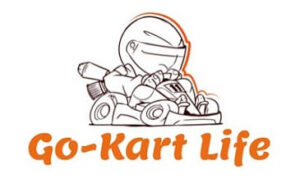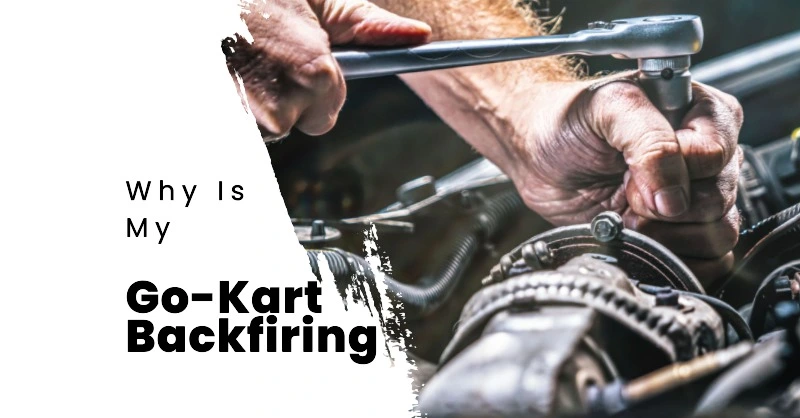Go-karts are the perfect way to enjoy a sense of freedom and independence. Whether you’re racing around your neighborhood or just cruising down the street, nothing quite compares to the feeling of being in control behind the wheel.
But what happens when that go-kart backfires? It’s not only annoying, but it can also be dangerous if left unchecked. In this article, we’ll explore why your kart might be backfiring and how to troubleshoot it so you can get back on the road quickly and safely.
The sound of an engine backfiring is unmistakable – a loud bang followed by a puff of smoke from the exhaust pipe – but what causes it? Backfiring usually occurs because there’s something wrong with your fuel mixture or ignition timing; both must work together harmoniously for smooth operation. We’ll look at each one in turn and other potential causes, such as clogged air filters, faulty spark plugs, and more.
Finally, we’ll discuss preventative measures you should take with your go-kart, so you don’t have to worry about these problems again. You can enjoy that freedom out on the open road by understanding what makes a kart run smoothly and taking regular go-kart maintenance steps. So let’s explore why your go-kart may be backfiring – read on!
| Key Takeaways |
|---|
| A backfire on a go-kart is a loud bang or pop from the exhaust, caused by unburned fuel igniting in the exhaust system due to incorrect fuel mixture, spark plug misfiring, or restricted airflow. |
| Common causes of go-kart backfires include fuel pressure issues, air filter problems, and spark plug gap misfiring. |
| To fix backfires on a go-kart, check fuel pressure settings, inspect air filters for blockages, adjust spark plug gaps, and ensure a proper air/fuel mixture balance in the engine cylinders. |
| Regular go-kart maintenance, including cleaning the carburetor, unclogging air filters, checking fuel filters and pipes, and changing spark plugs, can prevent backfires and improve the overall performance of your go-kart. |
What Is A Backfire On A Go-Kart?
A backfire on a go-kart is an unexpected loud bang or pop that’s produced from the exhaust. It occurs when unburned fuel enters and then ignites in the exhaust system. This happens due to an incorrect fuel mixture, spark plug misfiring, or restricted airflow.
When this takes place, it can cause damage to your engine and even start fires if left unchecked. Therefore, it’s important to understand why your go-kart might be backfiring so you can address the problem quickly and prevent further damage.
Identifying what type of issue is causing the backfire will help you determine how best to resolve it. Understanding these potential causes can also save you money since fixing a backfire requires different strategies depending on its root cause.
What Causes Go-Kart Backfires
Now that we understand what a backfire on a go-kart is let’s look at the possible causes. Usually, these can be broken down into three categories: fuel pressure issues, air filter problems, and spark plug gap misfiring. Let’s explore each in more detail to identify better and fix any potential source of your go-kart backfires.
Fuel Pressure Issues: Poor or improper fuel pressure can cause unburned fuel to escape through the exhaust system, leading to backfires. If you suspect this might happen, it’s important to check the carburetor settings and adjust them correctly for optimal performance. Additionally, ensure that all clamps are properly secured, so there aren’t any leaks in the lines.
Air Filter Problems: Clogged-up air filters reduce airflow, which can create an imbalance between air and fuel entering the engine cylinder resulting in backfiring. This issue is especially common when using aftermarket parts such as nonstandard race filters with high resistance levels. To prevent this from occurring, regularly inspect your filters for blockages and replace them if needed.
Spark Plug Gap Misfiring: Incorrectly set spark plug gaps may lead to incomplete combustion, causing unburnt fuel to enter the exhaust pipe, creating a loud bang or pop known as a backfire. Ensure you have checked for the correct gap settings before running your go-kart; otherwise, this could become an expensive problem over time due to wasted fuel and damage caused by excessive heat buildup inside the engine cylinders from incorrect firing timing.
To wrap up our discussion on why your go-kart may be backfiring, here is a summary of key points worth remembering:
- Check fuel pressure settings and make sure no clamps are leaking
- Inspect air filters frequently for signs of blockage
- Adjust spark plug gaps according to manufacturer specifications
- Ensure proper air/fuel mixture balance entering engine cylinders for efficient combustion.
How To Fix Backfires On A Go-Kart?
It’s a tall order, but fixing backfires on your go-kart doesn’t have to be an uphill battle. With some patience and the right know-how, you can get it running smoothly as butter in no time. Let’s look at what must be done for two and four-stroke engines.
For two-stroke engines, check the fuel filter for any blockages or dirt preventing proper fuel flow from reaching the engine. If there are signs of debris buildup, replace the filter with a new one before making any other adjustments.
Next, inspect the exhaust system for any damage or clogs that may restrict air intake or release of gases which could lead to backfiring issues. Lastly, ensure all carburetor settings are accurate according to manufacturer specifications so there is a proper balance between air/fuel mixture entering the cylinder resulting in optimal performance.
Similarly, if your go-kart has a four-stroke engine, check spark plug gaps first and foremost since misfiring due to incorrect gap settings can cause backfire problems. Additionally, ensure all clamps are correctly secured. Hence, no leaks along fuel lines cause unburned fuel to escape through the exhaust pipe, leading to popping noises coming from the muffler area during acceleration or deceleration phases riding it.
Finally, please pay close attention to air filters ensuring they are not blocked up because this reduces airflow creating imbalances in the combustion process, leading to backfiring again.
With these tips in mind keeping your go-kart running smoothly should become second nature over time! So don’t let backfires put you off enjoying life on wheels – follow our advice, and soon enough, you will be tearing down those tracks without worrying about anything other than where the next turn will take you!
Clean Carburetor
Now that your exhaust system and fuel lines are in check, it’s time to give the carburetor some extra TLC. Cleaning the carburetor is essential for optimal performance as it ensures a proper air-fuel mixture entering the engine during the combustion process. Clogged-up carbs can cause backfires, so ensure they’re good to go before tackling other potential problems!
Start by removing the intake manifold from the top of the motor and all its associated components, such as fuel pipes and throttle linkages. If there has been too much build-up on these parts, replace them with new ones – this will help reduce the chances of clogs or blockages leading to further issues when driving the kart around the track.
Then use carb cleaner spray to clear out any debris inside the chamber before reassembling everything again, ensuring a tight seal between each part and no leaks occur when running the vehicle at full speed later.
TIP: It may be worth investing in a rebuild kit if you find that cleaning isn’t enough; sometimes worn-out gaskets, O-rings, jets, etc., need replacing if they become damaged due to prolonged usage over time – this will save you money in the long run since less frequent maintenance visits needed compared to buying single pieces here and there every few weeks instead!
Unclog Air Filters
The next step in troubleshooting your go-kart’s backfiring is to check the air filters. If they’re clogged up, it can cause a popping sound and reduce fuel economy. To unclog them, remove the filter cover and the element for cleaning.
Wipe away any dust or dirt buildup with a damp cloth and ensure all crevices are clear from debris so that air can flow freely through when you reassemble everything. It may be worth investing in some replacement parts if necessary, as this will also help improve the engine’s performance over time!
TIP: Don’t forget to inspect other components, such as spark plugs, while you’re at it – these often get overlooked but can impact how well your vehicle runs, particularly if any misfiring occurs due to worn-out coils or faulty wiring connections!
Check the Fuel Filter, Pipes & Mixture
Now that you’ve unclogged the air filters, it’s time to check the fuel components. A worn-out or clogged-up fuel filter can cause power loss and backfiring, so make sure all pipes are clear from debris and inspect your mixture too. If there is a blockage in any of these areas, this could be causing the problem.
Replacing the parts may be necessary if worn out – otherwise, clean them with an appropriate solvent cleaner and ensure everything is connected properly before trying again! It might also be worth checking for loose wiring connections, as these can lead to misfires, creating a popping sound when accelerating.
Change Spark Plugs
At this point, it could be worth looking at the spark plugs. If they are worn out or damaged, then replacing them should help improve backfiring issues. Replacing your spark plugs regularly is essential for optimal performance, so if you haven’t done so lately, now may be the time! Here’s what to look out for:
- Check the gap between electrodes – if it’s too wide or too small, then adjust accordingly
- Make sure each plug has a good connection with its wire
- Inspect each plug visually and replace any that appear cracked, discolored, corroded, or burnt out.
- ✪ 100% brand new and high-quality spark plug A7TC.
- ✪ Compatible with: NGK: C7HA, C7HSA, C5HA, C5HSA, C5HSB, CR5HS, CR5HSA, CR5HSB, C6HA, C6HSA, CR6HS, CR6HSA, CR7HSA. U22FS-U, U16FS-U, U16FS-UB, U16FSR-UB, U20FS-U, U20FSR-U, U22FSR-U. Champion: PZ7HS, Z9Y, Z10, Z10YC, Z12, Z8, Z9Y. AC S102F....
- ✪ For GY6 50cc-125cc horizontal engines. For 50cc-70cc 90cc 110cc 125cc 140cc 150cc 160cc engines. For most motorcycle, atv, quad, scooter, go kart, moped, chopper, buggy , pit bike, dirt bike, racing bike, mini bike and other bike.
If all else fails and you’re still experiencing backfires, then there may be an issue with your carburetor requiring professional attention. It could also indicate a problem with engine compression or ignition timing – both of which need to be looked into by a qualified mechanic. These steps should get your go-kart up and running again soon – giving you more freedom on the track!
Related Article: How to Fix a Go-Kart That Won’t Start
Conclusion
In conclusion, keeping your go-kart well-maintained and using the right fuel to prevent backfires is important. The best option is high-octane gasoline that contains less than 10% ethanol. It’s also essential to ensure that the spark plugs run at an optimal temperature and that the air filter is changed regularly. Finally, adjusting the carburetor can also help you perform better from your go-kart.
Overall, by understanding why your go-kart might be backfiring and taking steps to address this issue through proper maintenance, you can keep yourself safe while enjoying time in your vehicle. I hope this article has provided useful information on identifying and resolving any issues with your kart when they arise!
Frequently Asked Questions
What Is The Best Type Of Fuel To Use In A Go-Kart?
It’s no secret that fuel is the lifeblood of any go-kart. It can make or break your racing experience, so it pays to know what type to use to get the most out of your engine. To put it bluntly, picking the wrong fuel for a go-kart could be like pouring gasoline onto a fire – not only will it backfire, but you may get burned too!
Several factors must be considered when selecting the right fuel for a go-kart. First, understand how much power your engine requires and find the appropriate octane rating. Most modern karts run on higher-octane fuels that perform better than low-octane ones.
Additionally, look into which fuel brand works best with your particular model; this is where research comes in handy, as some brands have been known to cause issues when used in certain engines. Finally, always check the expiry date before purchasing; nothing ruins a race day faster than running out of fresh gas mid-track!
In short, selecting an appropriate fuel for your go-kart can mean all the difference between having a successful or frustrating race day. So don’t take shortcuts – do your due diligence first and ensure you’re fuelling up with something that’ll keep you going strong until you cross that finish line!
Are Backfires On A Go-Kart Dangerous?
Backfiring on a go-kart is one of the more common issues with small-engine vehicles. It can be quite alarming, but it’s important to remember that it usually isn’t something serious. Backfires are generally caused by running too rich or too lean a fuel mixture in your engine and can often be fixed without taking drastic measures.
Fortunately, as long as you address them quickly, most backfire problems won’t cause any lasting damage. However, if left unchecked for an extended period, they could lead to major mechanical failure inside the engine. So while not dangerous, backfires should always be taken seriously and addressed promptly.
TIP: If you think your go-kart might have a backfiring issue, check out the carburetor first; this is typically where these types of problems originate. By simply cleaning and adjusting the carburetor settings correctly, you may be able to resolve the problem before needing to call in a specialist mechanic or make any expensive repairs!
What Temperature Should The Spark Plugs Be Running At?
John had been tinkering with his go-kart for weeks. He thought he’d gotten it running perfectly, only to find that something was still off – the engine kept backfiring! What temperature should spark plugs be running at?
Temperature is an important factor when considering a go-kart’s performance. For example, John discovered that if the spark plug in his kart weren’t hitting exactly 1450°F (788°C), the engine would misfire and cause a loud boom each time he accelerated. This could lead to serious damage over time.
To keep his engine firing on all cylinders, John needed to ensure his spark plugs were burning hot enough without getting too hot or cool. He used a thermometer to measure how quickly heat dissipated from the engine and what temperatures the spark plugs reached during operation. By doing so, he could adjust them accordingly and eliminate those pesky backfires once and for all!
Good maintenance practices are key to keeping your go-kart running smoothly and safely – especially when ensuring your spark plugs don’t overheat or underperform. Taking some extra steps upfront can save you lots of costly repairs!
How Often Should The Air Filter Be Changed?
Keeping an air filter in good condition is essential for the proper functioning of a go-kart. The air filter helps keep dirt and debris from entering the engine, which can cause serious damage over time. But how often should it be changed?
Air filters typically need to be replaced every 25 hours or so of use – depending on how dusty and dirty the environment your kart operates in. To maximize performance and minimize backfiring issues, you should inspect the air filter regularly and replace it when needed. Additionally, using higher-quality air filters designed specifically for go-karts will help keep your engine running clean and reduce the risk of further problems.
Regular inspection and replacement of your kart’s air filter will ensure optimal performance with minimal maintenance – allowing you to enjoy many hours behind the wheel without worrying about backfiring issues!
Is It Possible To Adjust The Carburetor On A Go-Kart?
Adjusting the carburetor on a go-kart can be tricky, but it’s definitely doable. It requires understanding your vehicle and how its components work together to give you the performance you need for your ride. To help make this process easier, here are some tips:
- First, check out online tutorials or videos that explain what must be done to adjust the carburetor correctly. This will give you a better idea of where everything is located and how it works together.
- Get yourself a reliable tool kit with all the necessary items for the job – including screwdrivers, pliers, and other essential tools. Having these readily available will save time when something unexpected happens during the adjustment process.
- Lastly, wear protective gear like gloves, goggles, and thick clothing to protect yourself from sharp objects or fluids that could get spilled while adjusting.
Adjusting your own go-kart’s carburetor properly can bring feelings of accomplishment and pride – not only because of mastering such a complex technique but also because you’ve taken one more step towards gaining freedom over your hobby!
The key is knowledge, so take some time to research as much as possible before diving into anything too technical. With patience and practice, you’ll soon become an expert at adjusting your go-kart’s carburetor – giving you complete control over how fast (or slow!) you want to ride!

Goran, an experienced go-kart racer, fuels GoKartLife.com with his passion and expertise. He offers valuable insights and tips for fellow enthusiasts, fostering the growth of the go-kart community. Join Goran at GoKartLife.com and immerse yourself in this exhilarating sport.


